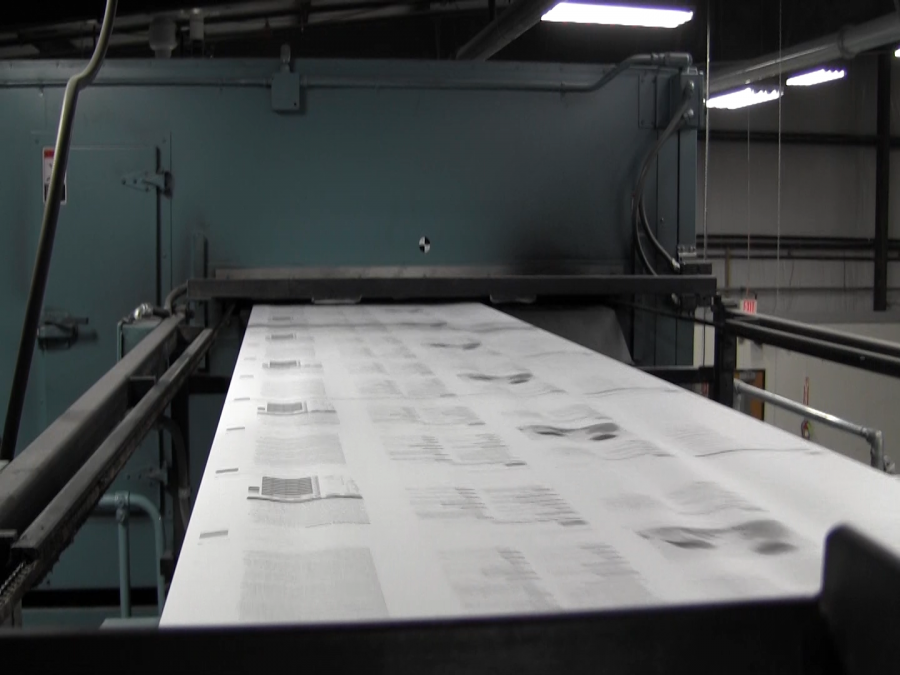If you ever get the chance to visit a printing press, do it. I’ve had the privilege to visit two of them. The first was in the late 80s in Cincinnati at Standard Publishing’s printing press. (That facility closed in 2004.) Their plant was quite large and did a wide variety of printing, everything from books to church curriculum to Star Wars coloring books. It was rather amusing to see those Star Wars coloring books on a pallet next to Sunday school take-home papers. Hope they didn’t mix them up!
The other plant was Bethany Press International in Bloomington, MN. During my years with Bethany House Publishers I visited this facility many times since their building is about 100 yards from the back door of the publishing company. It was fun to take our authors on a tour to see their books come “hot off the press.”
The beauty of watching the books being printed is partly the fascination of cool machines, but also an insight into all of the incredible details that go into the manufacturing process.
Many may not know that books are usually printed in 16-page increments called “signatures.” This is because the pages are printed on two sides, then folded, bound, then cut. Take a look at the top edge of a typical hardcover book. You’ll see the image below. Each section is a signature. That is why you’ll find blank pages at the end of some books. They are not for note taking; it is simply leftover paper. That is why you see a page count of 192 or 224 or 320, etc.
There are times where 32-page or 64-page signatures are also used for printing efficiency. But an 8-page signature is an extra expense as it is not as efficiently handled by the offset web presses.

Note, however, that print-on-demand does not have this blank-page problem. They literally charge for each page printed. Thus having blank pages in the back is unnecessary.
Also there are certain book-jacket treatments that make a book feel or look special. The standard lamination is what we are used to seeing because it is the most inexpensive process. That is the glossy lamination on the majority of books.
Some books get a matte finish, which gives a tactile feel to the cover, almost a rough, yet smooth, touch. This has become more common over the years.
Next is the spot-gloss finish. This is where they start with the matte finish above, but use the gloss lamination on specific spots on the cover. They might laminate only the letters in the author’s name, the face of the character on the jacket design, or maybe only the title. This is an additional cost for every book printed.
Last is the embossing or stamping process where they created a metal plate that stamps an imprint on every jacket. So instead of a flat cover, each book has embossed, or raised, letters or symbols. This can be expensive because the publisher must first create the metal stamp (a few hundred dollars just for the plate). Then, after the cover is printed, each jacket must be run through the process a second time to stamp the imprint into the paper. This is very labor intensive and a lot of spoilage can happen if the imprint starts to miss its mark. We’ve all seen a few books that got past the inspectors where the stamp doesn’t fit the design by being off by as little as a sixteenth of an inch.
And then some really special books get a gold foil that is also applied to the cover before the embossing process.
Why am I telling you all this boring stuff? Partly because its fun for book nerds! But also it can help you understand the big picture behind the traditional publishers who use offset web press print runs. The following is a four minute video of the printing process of The Lost Symbol by Dan Brown. It takes you behind the scenes of a printing company to see it at work. This book was released in 2009 with a first printing of 5,000,000 (five million) copies. Note the cover treatments described above as they are applied to the manufacturing of this book. The publisher had to use more than one printer to fill this print order. At the stated rate of 30,000 books per hour, a single press must run for more than 167 hours (nearly seven full days) to print that many books! Thus they had to spread it out among many presses.
[an earlier version of this post ran in September 2009]


